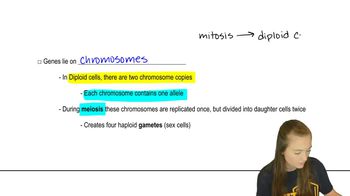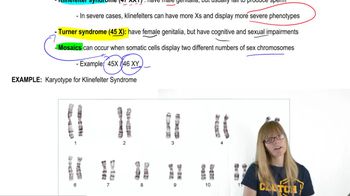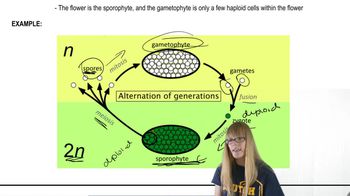Dr. Ara B. Dopsis has an idea he thinks will be a boon to agriculture. He wants to create the 'pomato,' a hybrid between a tomato (Lycopersicon esculentum) that has 12 chromosomes and a potato (Solanum tuberosum) that has 48 chromosomes. Dr. Dopsis is hoping his new pomato will have tuber growth like a potato and the fruit production of a tomato. He joins a haploid gamete from each species to form a hybrid and then induces doubling of chromosome number.
How many chromosomes will the polyploid have after chromosome doubling?
Table of contents
- 1. Introduction to Genetics51m
- 2. Mendel's Laws of Inheritance3h 37m
- 3. Extensions to Mendelian Inheritance2h 41m
- 4. Genetic Mapping and Linkage2h 28m
- 5. Genetics of Bacteria and Viruses1h 21m
- 6. Chromosomal Variation1h 48m
- 7. DNA and Chromosome Structure56m
- 8. DNA Replication1h 10m
- 9. Mitosis and Meiosis1h 34m
- 10. Transcription1h 0m
- 11. Translation58m
- 12. Gene Regulation in Prokaryotes1h 19m
- 13. Gene Regulation in Eukaryotes44m
- 14. Genetic Control of Development44m
- 15. Genomes and Genomics1h 50m
- 16. Transposable Elements47m
- 17. Mutation, Repair, and Recombination1h 6m
- 18. Molecular Genetic Tools19m
- 19. Cancer Genetics29m
- 20. Quantitative Genetics1h 26m
- 21. Population Genetics50m
- 22. Evolutionary Genetics29m
6. Chromosomal Variation
Chromosomal Mutations: Aberrant Euploidy
Problem 22
Textbook Question
Two experimental varieties of strawberry are produced by crossing a hexaploid line that contains 48 chromosomes and a tetraploid line that contains 32 chromosomes. Experimental variety 1 contains 40 chromosomes, and experimental variety 2 contains 56 chromosomes.
Do you expect both experimental lines to be fertile? Why or why not?
 Verified step by step guidance
Verified step by step guidance1
Determine the ploidy levels of the parent lines. The hexaploid line has 48 chromosomes, so the base chromosome number (x) is 48 ÷ 6 = 8. Similarly, the tetraploid line has 32 chromosomes, so its base chromosome number is 32 ÷ 4 = 8. Both lines share the same base chromosome number (x = 8), which is important for compatibility during hybridization.
Analyze the chromosome number of experimental variety 1 (40 chromosomes). Since 40 is not a multiple of the base chromosome number (8), this suggests that the chromosomes may not pair evenly during meiosis, leading to potential fertility issues.
Analyze the chromosome number of experimental variety 2 (56 chromosomes). Since 56 is a multiple of the base chromosome number (8), this suggests that the chromosomes can pair evenly during meiosis, which is more likely to result in fertility.
Explain the relationship between chromosome pairing and fertility. Fertility in polyploid organisms depends on the ability of chromosomes to pair evenly during meiosis. Uneven chromosome numbers (e.g., 40 in variety 1) can lead to unbalanced gametes and reduced fertility, while even chromosome numbers (e.g., 56 in variety 2) are more likely to produce balanced gametes and maintain fertility.
Conclude by stating that experimental variety 1 is unlikely to be fertile due to its uneven chromosome number, while experimental variety 2 is more likely to be fertile because its chromosome number allows for proper pairing during meiosis.
 Verified video answer for a similar problem:
Verified video answer for a similar problem:This video solution was recommended by our tutors as helpful for the problem above
Video duration:
1mPlay a video:
Was this helpful?
Key Concepts
Here are the essential concepts you must grasp in order to answer the question correctly.
Ploidy Levels
Ploidy refers to the number of sets of chromosomes in a cell. In this case, the hexaploid line has six sets (48 chromosomes) and the tetraploid line has four sets (32 chromosomes). Understanding ploidy is crucial because it affects the fertility and viability of the offspring produced from these crosses, as mismatched ploidy levels can lead to complications in meiosis.
Recommended video:
Guided course

Diploid Genetics
Chromosome Number and Fertility
The number of chromosomes in an organism can significantly influence its fertility. In this scenario, experimental variety 1 has 40 chromosomes, while variety 2 has 56. Fertility is often compromised when the chromosome numbers of the parents differ significantly, as it can lead to unbalanced gametes and difficulties during meiosis, potentially resulting in sterile offspring.
Recommended video:
Guided course

Human Sex Chromosomes
Meiosis and Gamete Formation
Meiosis is the process by which gametes (sperm and eggs) are produced, involving two rounds of cell division that reduce the chromosome number by half. For successful reproduction, gametes must have compatible chromosome numbers. In this case, the differing chromosome counts in the experimental varieties may hinder proper pairing and segregation during meiosis, affecting the fertility of the resulting hybrids.
Recommended video:
Guided course

Formation of Plant Gametes
Related Videos
Related Practice
Textbook Question
364
views


